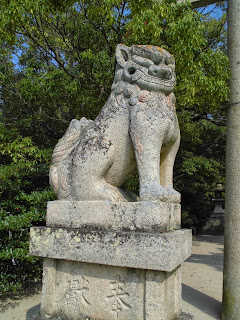After our grueling trip to Kochi, what did we do once back in Ehime? Why get back in the car and drive, of course! The weather was nice, so we went north to the islands along the Nishi Seto Expressway. This is a highway that goes from northern Ehime, across a series of islands, up to Honshu, the main island of Japan. It's one of three bridges linking Shikoku to Honshu. It was only built back in 1979, so it's not that old. It's an absolutely stunning bridge to go over because it treats you to all these wonderful views of the islands in the Seto Inland Sea. We went to one of those islands, Omi Island, an island famous for its large Shinto Shrine.
高知県の旅から帰ってきて、翌日また車に乗ってドライブしに行った。今回の目的地は大三島、大山祇神社が有名だという「神の島」だ。そこに行く為に、西瀬戸自動車道を使った。西瀬戸自動車道に乗って、瀬戸内海を渡っている時の風景は最高に綺麗だ!
我們回家、隔天在坐車去別的地方。這天是「大三島」(ㄡㄇㄧㄒㄧㄇㄚ)。大三島有一座非常有名的神社、叫「大山祇神社」。我聽說以前這座島的土地都算是聖地。為了到大三島、我們開車用西瀨戶自動車道。這條路通海上的幾座島上、風景非常漂亮。
大山祇神社の入り口だ。この神社は昔からあって、昔は島自体が全部神の地とされたらしい。そのため、漁業は禁止された。The shrine was filled with all these Komainu statues done in different styles. This is the first pair at the main entrance.
這些動物叫狛犬、像中國的石獅子那樣子。這座神社有很多種類。
神社内に、色々なスタイルの狛犬がいた。
"Oyamazumi Shrine"
Another pair of Komainu.
The shrine's mark.
大山祇神社の紋。
この二匹の顔は気に入った。
A very big, old tree on the grounds.
3000歳生きてきた楠木。
這棵樹是日本最古的樟樹。它是差不多三千歲。
A sign telling us that this tree is Japan's oldest camphor tree, at about 3000 years old. People historically prayed to it for rain, something very important on this island. The island is small and without large rivers, and the Seto Inland sea, since it's surrounded by mountains on all sides, tends to be drier than other parts of Japan.
昔は多分この辺しょっちゅう旱魃にあったのではないかと思う。瀬戸内海は基本的に雨が他の地域より少ないし、小さな島には水を溜める川や湖などがあまりない。
An old-school shinto building with stone lamps in front.
Another view of the old camphor.
Some person left a glass of "One Cup" sake here. I don't know if they did it as an honest offering to the tree, or if they are just a lazy jerk. But I can say this, "One Cup" is Japan's version of whatever the vilest type of malt liquor is in the US. It's cheap, and it's also just the worst thing.
このワンカップは、供え物かな?忘れ物かな?
For washing hands before entering the shrine's grounds further.
進神社去之前、先要洗手。
And here's the main building. The little structure in front, below the big, thick rope, is where we throw our money before praying to the gods.
本館
For some reason, the building to the left is very different in style.
接しているのに、建物のスタイルが全然違う。
雖然旁邊的建築、可是樣子完全都不一樣。
Those barrels are all barrels of sake.
There were a couple of miko washing the shrine while we there. One thing I always found interesting about modern miko in Japan is that it's a part-time job that college students and the like often do to make some extra cash, like working at McDonald's or something.
巫女さん!
這個人是一個巫女。(ㄇㄧㄎㄡ)她們在神社打工、常常是大學生。不一定是因為對神道非常熱心。衣服很可愛。
ああ、可愛い!愛してるよ!
To give you an idea of what a big deal this shrine is (it's known all over Japan) here's a photo of Hirobumi Ito visiting. There were a whole bunch of photos like this. Apparently, this shrine has a really long history, and I read somewhere that the entire island used to be considered sacred, and as a result fisherman couldn't catch fish in the waters around it. (Shinto considers death and blood unclean, so fisherman dragging dead fish to shore and cutting them open every day would clash with the island's sacred function.)
この写真は伊藤博文が訪れた時の写真だ。この神社は本当に大したもんだ。
我已經跟你說、這座神社很有明。這照片是伊藤博文來這裡的一片。
Komainu with strange tails.
尻尾は結構変わっている。
A sign informing us that the 38 camphor trees on the shrine grounds were all designated National Treasures by the government in 1951.
在神社裡面的三十八棵樟樹都是政府指定國家寶物。
This looks something you'd see at a Buddhist temple in south asia.
私的には、これが凄く南アジアの仏教関係のものに見える。
我覺得這個東西看起來南亞佛教的建築。
A stone lamp with modern adaptations.
Some sort of lizard.
蜥蜴もいた。
蜥蜴出沒!
We leave this Shinto island and head to a Buddhist one!
次:神の島を出て、仏の島に行く。
下次我們要離開這座神的島、去佛的島。














































No comments:
Post a Comment